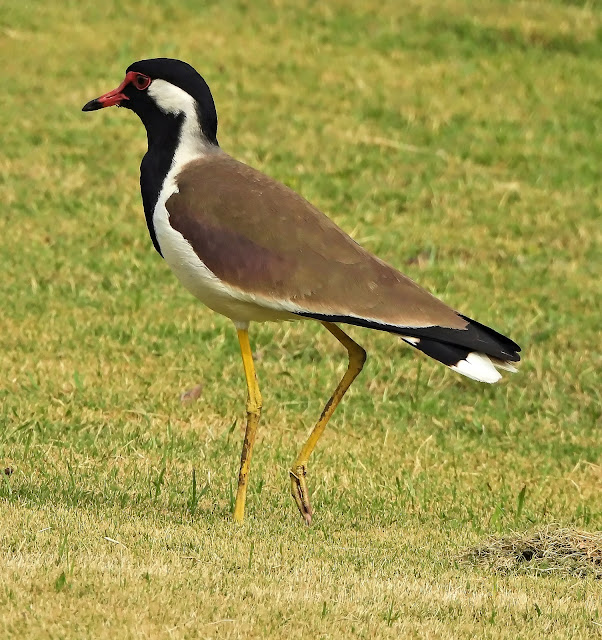The Red-wattled lapwing (Vanellus indicus) is large wader native to Asia. Like other lapwings, they are ground birds that are incapable of perching. This bird has many local names such as titahri (Hindi), titawi (Marathi), tittibha (Kannada), tateehar (Sindhi), titodi (Gujarati), hatatut (Kashmiri), balighora (Assamese), yennappa chitawa (Telugu), aal-kaati (Tamil, meaning "human indicator").
Red-wattled lapwings are large birds. Their wings and back are light brown with a purple to green sheen, but the head, a bib on the front, and the back of the neck are black. Prominently white patch runs between these two colors, from the belly and tail, flanking the neck to the sides of the crown. The short tail is tipped black. A red fleshy wattle in front of each eye, a black-tipped red bill, and long legs are yellow. In flight, prominent white wing bars formed by the white on the secondary coverts. Males and females are similar in plumage but males have a slightly longer wing and tend to have a longer carpal spur.
Several males may display to females and they may be close together. The eggs are laid in a ground scrape or depression sometimes fringed with pebbles, goat or hare droppings. The female lays 3-4 black-blotched buff eggs shaped a bit like a peg-top (pyriform). Nests are difficult to find since the eggs are cryptically colored and usually match the ground pattern. In residential areas, they sometimes take to nesting on roof-tops. When nesting pairs are very territorial and will attempt to dive bomb or distract potential predators. Both parents incubate the eggs and divert predators using distraction displays or flash their wings to deter any herbivores that threaten the nest. Males relieve females incubating at the nest, particularly towards the hot part of noon. The eggs hatch in 28 to 30 days. When the chicks hatch they are cryptically patterned and immediately follow their parents to feed, hiding by lying low on the ground or in the grass when threatened. Parents often soak their belly feathers to provide water to their chicks as well as to cool the eggs during hot weather.


